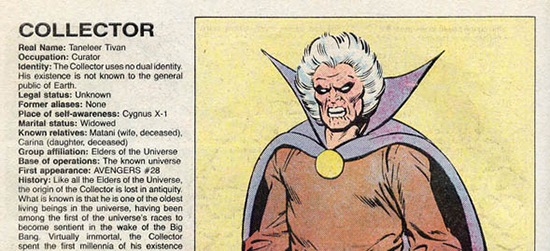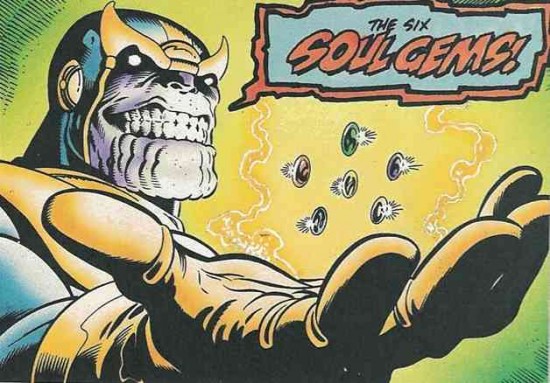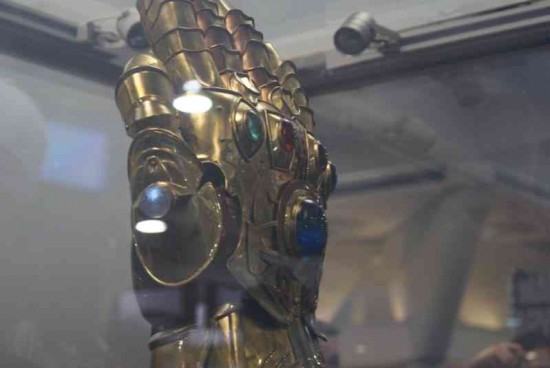Who's The Guy At The End Of 'Thor 2,' And What Does He Mean For The Marvel Cinematic Universe?
Time for more Thor: The Dark World spoiler talk, specifically with respect to the mid-credits tag in the film. If you saw the movie this weekend and wondered what was going on with that guy in the first tag, all the explanation you need is below, along with some educated guesses about what the scene means for future Marvel films.
Let's start with...
 The Collector
The Collector
The mid-credits tag introduces Benicio del Toro as the Collector, who will have a much more significant role in Guardians of the Galaxy. He's a being who, well, collects items of power and import. That's why he's shown in the brief scene amid all the cases and tubes holding what appear to be aliens and specimens.
Millions of years old, the Collector is an Elder of the Universe, a telepath, and possesses precognitive powers. Specifically, he's good at seeing stuff that might get in the way of he and other Elders. Even more specifically, he was good at seeing the coming of Thanos, who he viewed as a great danger to the Elders and the universe. (And who we saw very briefly in the mid-credits tag of The Avengers.) While the Collector originally started to gather stuff as a way of dealing with his wife's death — they were both effectively immortal, but she gave it up, and passed away, leaving him adrift — he began collecting in earnest to protect stuff from Thanos and others like him.
In short, the Collector is kind of (sometimes) Marvel's version of Noah, building a museum rather than an ark, filled with the stuff needed to repopulate a universe destroyed by Thanos. He's just Noah with the power of a god.
As such, he isn't good or evil exactly. He's got a perspective that is so cosmically different from human experience that his actions effectively appear villainous (as when he has "collected" various heroes) and his great power makes him a tough character to deal with. Which is also to say, he's a little kooky (Guardians director James Gunn described him as "like an outer-space Liberace") , and that can be a problem if you're on the wrong side of what he wants.
At the end of Thor: The Dark World, the Collector takes possession of the Aether, then ominously says "one down, five to go." What's that about?
 The Infinity Gems (or Soul Gems)
The Infinity Gems (or Soul Gems)
There are six color-coded Infinity Gems in the Marvel Universe. They were introduced over a period of years, starting with the character Warlock, who wore one in his forehead. The gems were fully defined, as we know them now, in the Thanos Quest story, which saw Thanos seeking to gather all the stones to place them in the Infinity Gauntlet and gain incredible power.
The gems are the remnants of a godlike being, and convey incredible power on their own. When brought together, the bearer is essentially omnipotent. The guantlet is essentially a cool way to hold the gems and be able to make the most powerful fist in the universe.
Here's a rundown of the gems, which can also be sentient in some manner.
In the comics these are all actually small stones. The neat thing that Marvel is doing on film is that the gems or stones don't actually have to stones. They're simply items of power.
So the Tesseract from Captain America: The First Avenger and The Avengers is one. (In fact, it is the Space Gem, says Kevin Feige, not the Mind Gem as some have assumed, thanks to its blue color.) The Aether from Thor: The Dark World is another, but we don't know which gem it is. People are already talking about the fact that Loki may have one as the centerpiece of his staff in The Avengers — his ability to control minds sounds like the blue gem, even though Loki isn't nearly as powerful as holding the gem would seem to indicate he could be.
Where could others lie? In the comics characters such as Iron Man, Doctor Strange, and Reed Richards have them in safe keeping. That's obviously got to change somewhat on film, as Marvel does not have the screen rights to Richards, for example. But Doctor Strange, long assumed to be part of Phase Three, could have one in his possession.
Kevin Feige said the following to Germain when they talked about Thor: The Dark World:
We are always building towards additional things, and what's fun about that reveal for fans of comics and fans of movies is that's the first time that we reveal that The Tesseract is an infinity stone, that ether is an infinity stone. You may see another infinity stone in Gaurdians, and certainly fans of the comics know what one can do with all of those stones if, god forbid, they get them [together]. With Thanos showing up at the end of Avengers, he also plays a part in Gaurdians, and leads us towards at least one potential future.
 The Infinity Gauntlet, Thanos, and the Future (and Possibly the Past) of the MCU
The Infinity Gauntlet, Thanos, and the Future (and Possibly the Past) of the MCU
As mentioned, the Infinity Gauntlet was, in the comics, a means by which Thanos could wield all six gems at once. We've seen a prop of the gauntlet (above) in the first Thor film, which is interesting for reasons I'll get to below. We know that Thanos is in love with Death, and James Gunn has said that Thanos "employee" Ronan the Accuser is the primary villain in Guardians of the Galaxy. Comics history suggests Thanos wants to gather all the gems to reconstitute (or create) the Infinity Gauntlet, the better to destroy everything and arrange a meet cute with Death.
The Collector's brief line in Thor 2 is pretty inscrutable, given what we know about the guy. He doesn't seem friendly. The character's history, however suggests that he opposes Thanos, and does not want to gather the gems to help out the big grey guy.
Here's a question: we know the Infinity Gauntlet already exists in the Marvel Cinematic Universe, because we saw it in Thor, and Marvel specifically ID'd the prop at Comic Con. Which suggests it was made for the gems, which we now know may not actually be gems. Furthermore, it also suggests that Thanos has already had all the gems, but he clearly does not have them all now. Confusing?
(The prop even seems to have the gems embedded, but hey, not everything can be predicted years in advance when these movies are being made.)
There are a couple answers, and they may lie with the power of the gems. The bearer of the Time and Space gems could theoretically drop the gauntlet way back in time to be corralled in Asgard. The owner of the Reality gem could do the same. The Reality gem could also conceivably turn the other gems into objects, or at least incarnate the gems' power into objects. That would require some big time/space/matter bending, but the Marvel Cinematic Universe is headed steadily in the direction of storytelling where that wouldn't be such a weird thing.
In light of that thought, Feige's "one potential future" comment is interesting. Is Marvel building towards the sort of thing that comics do all the time — build a big story world and then use some super-powerful item or character to wipe the slate clean? We're starting to see inklings of that with the fates of characters like Coulson and Loki. Just how much time warping can we expect in Guardians and Phase Three?
The great thing about the gems is that they can make just about anything happen, but that can also be a shortcoming. It can be a big, easy out when writing. Audiences buy into what Marvel has done because it all fits together. Abusing that power, and the power of these items, could really change the films' relationship with the people who have enthusiastically shown up so far.
